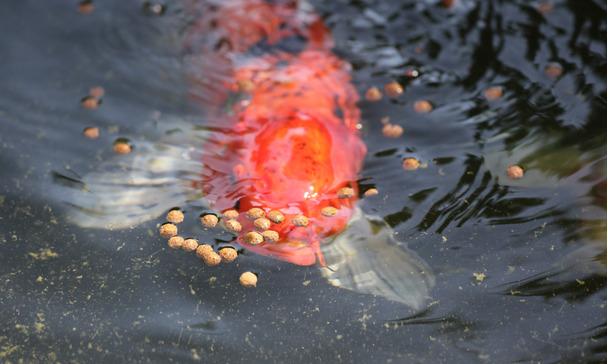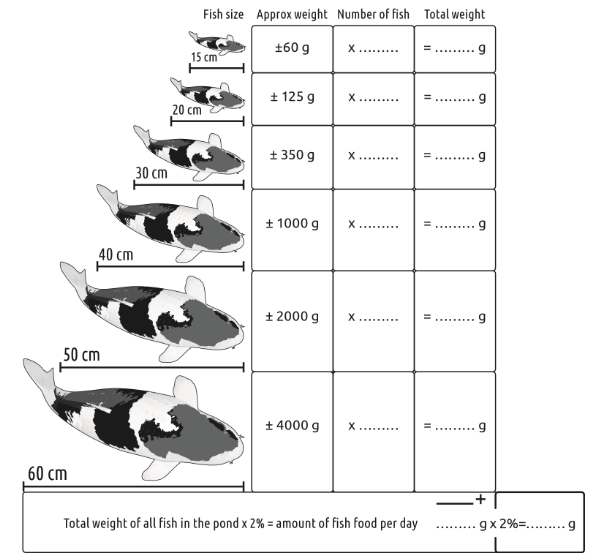Fish Food: When to Feed your Fish and What Food to Use

Most fish are omnivorous, and will eat a variety of food, such as peas, spinach, wheat germ, plankton, blood worms, shrimp, and algae. However, a fish’s diet does depend at least somewhat on water temperature. In warmer waters (or in summertime, where the water temperature will hit 15 degrees C or higher), fish metabolism is high, and you should feed them with protein-rich foods. In cooler waters (15 degrees C or lower), a diet lower in protein and higher in carbohydrates is more suitable as their metabolisms are lower and they won’t need as much energy as in warmer months. To follow the temperature of the water, you can use a floating pond thermometer.
One of the key things to remember when feeding fish is to avoid overfeeding them. Our top tips blog post and our common pond mistakes blog go into further detail, but essentially leftover food can adversely affect your ponds chemistry and may result in a build up of sludge and algae. An easy way to prevent this is using a feeding ring.

Pond fish are “cold blooded”, and the amount of food needed depends upon their activity, which is closely tied to the water temperature. You can use a floating pond thermometer to measure the water temperature; if not, air-temperatures from forecasts are a good alternative.
Feeding during the milder days of autumn can help to build fish up for their winter “down time” and feeding in the warmer days of spring will help them to recover from the winter. Goldfish and Koi become very sluggish below 8-10 degrees and it is generally best not to feed them below these temperatures or if there is any ice on the pond. Food can be left uneaten and disrupt the chemistry of the water or cause problems with fish digestion. Even when spring arrives, feed only lightly until the weather is warmer.
In the autumn, when really cold weather finally arrives, it is best to stop feeding altogether. Only start feeding again when temperatures rise reliably above 10 degrees in the spring. Feeding during intermittent mild spells of warmer weather in the middle of winter can result in fish using their energy continuing to look for food after the mild spell has ended. They can usually find a little natural food in these brief breaks from winter.
As the temperatures rise, fish appetites will increase. In spring and early summer any biological filter system will be recovering from the winter. It is best to increase feeding quantities gradually so that the filter and pond bacteria can adapt to the increasing amounts of fish waste.
.png)
Types of Fish Food
Flake Food
Flake food is normally used for indoor fish; but when it comes to garden ponds, they do have their limits.
You will need to sprinkle the food just above the water’s surface, as the flake food can be blown away in the wind. Flake food is also not suitable for Koi, as it will not keep them satisfied.
Flake food is best for small and medium ponds with smaller or medium fish; they are great as a treat with other food and as the flakes take on water, the flakes sink so mid and bottom feeding fish can eat it.
Examples of flake food include the PondXpert Flake Food and Natures Grub Pond Flake Food.

Pellet Food
Pellets are bigger and denser than flake and stick food; which makes them ideal for medium to large fish. They are particularly ideal for bottom feeders, but leftover food can impact on your water quality.
Pellets offer your fish the healthy balanced diet they need; containing essential vitamins and minerals as well as being high in protein.
Available as floating and sinking pellets, we would advise using floating pellets, you can monitor how your fish are eating and you can remove any excess pellets not eaten with a pond net.
Examples of the floating pellets include the PondXpert Staple Pellets and the Nishikoi Growth Pellets. Examples of the sinking pellets include PondXpert Sinking Pellets and Nishikoi Sinking Pellets.

Stick food is a very popular food to feed your pond fish, ideal for mixed fishponds as they are suitable for a range of different fish. When you throw the sticks into your pond, they will quickly soften making them easy for your fish both small and large to consume and digest.
They are usually lighter than pellet food and produce less waste; this makes them more efficient for your pond as they will affect the chemistry of the water less.
Examples of stick food include the Tetra Floating Pond Sticks and the PondXpert Pond Sticks.
When on holiday
If you are away for a weekend, your fish will browse on natural foods in the pond.
If you are away for longer, you can set up automatic feeders which will keep your fish fed. Or you can use holiday blocks. Alternatively, if you can ask someone to fish your fish for you, you can provide a measuring scoop to make this task easy for them.
Never provide extra food to make up for a day of missed feeding, it will likely pollute the water.
If you need any further assistance, please email us on info@pondkeeper.co.uk.